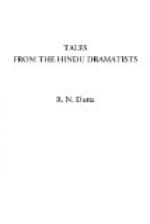The purposes for which an ancient language may be studied are its philology and its literature, or the arts and sciences, the notions and manners, the history and beliefs of the people by whom it was spoken. Particular branches may be preferably cultivated for the understanding of each of these subjects, but there is no one species which will be found to embrace so many purposes as the dramatic. The dialogue varies from simple to elaborate, from the conversation of ordinary life to the highest refinements of poetical taste. The illustrations are drawn from every known product of art, as well as every observable phenomenon of nature. The manners and feelings of the people are delineated, living and breathing before us, and history and religion furnish the most important and interesting topics to the bard. Wherever, therefore, there exists a dramatic literature, it must be pre-eminently entitled to the attention of the philosopher as well as the philologist, of the man of general literary tastes as well as the professional scholar.
THE ORIGIN OF DRAMA.
Among the various sorts of literary composition the drama holds the most important position; for it is a picture of real life, and, as such, of national interest. It consists of two principal species, tragedy and comedy; the minor species are tragi-comedy, farce, burlesque and melo-drama. Both tragedy and comedy attained their perfection in Greece long before the Christian era. There it originated in the worship of Bacchus.
The English drama took its rise from the mysteries or sacred plays by the medium of which the clergy in the Middle Ages endeavoured to impart a knowledge of the Christian religion.
The Sanskrit drama is said to have been invented by the sage Bharata, who lived at a very remote period of Indian history and was the author of a system of music. The earliest references to the acted drama are to be found in the Mahabhashya, which mentions representations of the Kansabadha and the Balibadha, episodes in the history of Krishna. Indian tradition describes Bharat as having caused to be acted before the gods a play representing the Svayamvara of Lakshmi.
Tradition further makes Krishna and his cowherdesses the starting point of the Sangita, a representation consisting of a mixture of song, music, and dancing. The Gitagovinda is concerned with Krishna, and the modern Yatras generally represent scenes from the life of that deity.
From all this it seems likely that the Hindu drama was developed in connection with the cult of Vishnu-Krishna; and that the earliest acted representations were, therefore, like the mysteries of the Christian Middle Ages, a kind of religious plays, in which scenes from the legends of the gods were enacted mainly with the aid of songs and dances supplemented with prose dialogues improvised by the performers. These earliest forms of Hindu dramatic literature are represented by those hymns of the Rig-Veda which contain dialogues such as those of Sarama and the Panis, Yama and Yami, Pururava and Urvaci.




